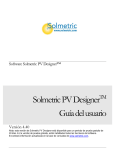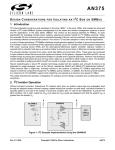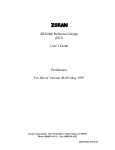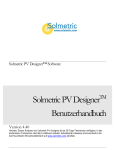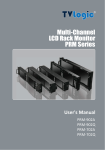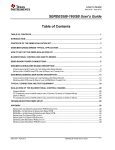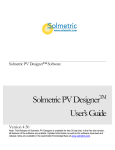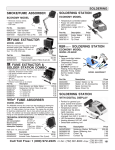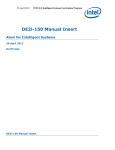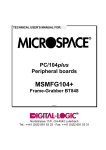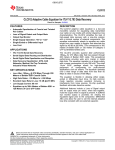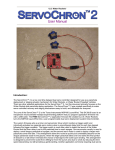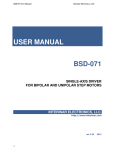Download Application Note 2173 I2C Communication Over FPD
Transcript
National Semiconductor Application Note 2173 Dac Tran July 14, 2011 Introduction and/or transmitter. The bus consists of two wires, the SCL (clock) line, and the SDA (data) line. The two wires are open collector/drain outputs and must be pulled high using an external pull-up resistor. A logic state low is transmitted by driving the output low. A logic high state is transmitted by releasing the output and allowing it to be pulled-up externally. The appropriate pull-up resistor values will depend upon the total bus capacitance and operating bus speed. The I2C bus is a two-wire serial interface. These wires convey information to and from devices connected to the bus, each of which is identified by a unique address. Each device can either transmit data or receive data. A device can operate as either a master or as a slave; depending on whether it generates or receives the serial clock (SCL). A master initiates a data transfer by addressing slave device and generates START and STOP signals. The I2C protocol allows for more than two devices to be connected to the bus and for multiple master/slave relationships to exist. This application note describes communication between devices using the FPD-Link III SerDes with a bidirectional control channel using I2C. The low latency bidirectional control interface allows the master I2C device to remotely control peripherals across the serial link. I2C Overview The Inter-Integrated Circuit (I2C) bus is a two-wire bidirectional bus that allows multiple devices to operate on the same bus (Figure 1). The bus consists of master and slave devices which transmit data back and forth over the I2C interface. Master devices control the bus and are typically microcontrollers, FPGAs, DSPs, or other digital controllers. The slave devices are controlled by a host controller. I2C uses a masterslave protocol when data is exchanged among devices. Each device on the bus (both master and slave) can be a receiver 30168801 FIGURE 1. Example of I2C Bus Acknowledge From Slave Device To communicate with a particular device on the bus, the controller (master) sends the slave address and listens for a response from the slave. This response is referred to as an “Acknowledge” (ACK = 1) or “No Acknowledge” (NACK = 0). The Acknowledge cycle consists of two signals: the acknowledge clock pulse the master sends with each byte transferred, and the acknowledge signal sent by the receiving device. All bytes transmitted on the SDA line consists of eight bits of data followed by an Acknowledge bit. Each byte transferred effectively requires 9 bits. The ACK bit allows data to be sent in one direction to one device on the bus, and to indicate the data was received. A device acknowledges a transfer of each byte by pulling the SDA line low during the 9th clock pulse of SCL. ACKs also occur on the bus when data is being transmitted. When the master is writing data, the slave ACKs after every data byte is successfully received. When the master is reading data, the master ACKs after every data byte is received to let the slave know it is ready to receive another data byte. When the master wants to stop reading, it NACKs after the last data byte and terminates with a stop condition on the bus. I2C Communication Over FPD-Link III with Bidirectional Control Channel I2C Communication Over FPD-Link III with Bidirectional Control Channel AN-2173 © 2011 National Semiconductor Corporation 301688 www.national.com AN-2173 30168802 FIGURE 2. Acknowledge On The I2C Bus an embedded a bidirectional control channel (referred as BCC) concurrently over a single differential link. The BCC interface is I2C compliant according to the I2C standard. The BCC interface provides access to programmable functions and registers on the local and remote device(s). Three types of operations are supported for I2C transactions with the bidirectional control channel SerDes chipsets: local, remote, and remote slave as shown in Figure 3. Each device can function as an I2C slave proxy or master proxy depending on the I2C mode of operation. The SerDes interface acts as a virtual bridge between host controller and the remote device. Local operations use standard master to slave operations to the local Serializer or Deserializer. Local I2C operations do not require any clock stretching by the slave and do not result in transactions across the bidirectional control link. When addressing a remote peripheral or SerDes, the slave proxy will forward any byte transactions sent by the Master controller to the target device. The device will function as a master proxy device; acts as a master on behalf of the I2C host controller. Clock Stretching In general, the I2C master controls the SCL clock line. This line provides timing of all transfers on the bus. When the master is reading from the slave, the slave sends data on the SDA line, but it is the master that controls the clock. However, there are situations where a slave device(s) is not ready to respond to the master or needs to slow down bus traffic. The I2C protocol defines a mode for the slave to hold the SCL line Low. This mechanism is known as “Clock Stretching”. When the slave receives the write/read command from the master it holds the clock line Low. During any SCL low period, the slave holds down SCL to prevent it from rising high again to delay the SCL clock rate and pause communication. When the master attempts to make SCL high to complete the current clock pulse, it should verify that SCL has really gone high. If it is still low, this indicates a slave is holding SCL low and the master must wait until SCL goes high before continuing Bidirectional Control Channel Using I2C The FPD-Link III Serializer/Deserializer (SerDes) chipsets support full-duplex transmission of high-speed video data and 30168803 FIGURE 3. Typical FPD-Link III Connection with I2C Bus www.national.com 2 CLOCK STRETCHING section. During this phase, the control channel is embedded on the link and then data is reconstructed on the remote bus. Note the slave device will not control the clock and only stretches it until the remote peripheral has responded. 30168804 FIGURE 4. Clock Stretch For Sent Byte Figure 4 shows an example of a remote access including the clock stretching period following the transmitted byte, prior to completion of the acknowledge bit. Since each byte transferred to the I2C slave must be acknowledged separately, the clock stretching will be done for each byte sent by the host controller. For remote accesses, the “Response Delay” shown is on the order of 5 – 10 us and 10 – 15 us for DS90UH925Q/UH926Q/UB925Q/UB926Q and DS90UB901Q/902Q/903Q/904Q respectively. The “Response Delay” includes the latency time of the control channel packing and serialization protocol across the differential link to the remote peripheral. The following diagrams (Figures 5, 6) show the timing relationships of the SCL clock and SDA data signals. 30168805 FIGURE 5. Write Format To Remote I2C Slave 3 www.national.com AN-2173 In order to communicate with remote devices on the I2C bus through the bidirectional control channel, slave clock stretching must be supported by the I2C host controller. The chipsets with a bidirectional control channel employ I2C clock stretching during remote data transmission; as described in the AN-2173 30168806 FIGURE 6. Combined Format Read From Remote I2C Slave approximate bit rate including latency timings across the control channel can be calculated by the following: Data Throughput To Remote I2C Slaves 9 bits / ((Host_bit * 9) + (Remote_bit * 9) + FCdelay + BCCdelay) Since the BCC buffers each I2C data byte and regenerates the I2C protocol on the remote side of the link, the overall I2C throughput will be reduced. The reduction is dependent on the operating frequencies of the local and remote interfaces. The local I2C rate is based on the host controller clock rate, while the remote rate depends on the settings for the proxy I2C master (SCL frequency). For purposes of understanding the effects of the BCC on data throughput from a host controller to a remote I2C master, the Example of DS90UH925Q/926Q/UB925Q/UB926Q chipset: For the 100 kbit/s (100 kHz) : Host_bit = 10us (100 kHz) Remote_bit = 13.5us (default 74 kHz) FCdelay = 1us (max) BCCdelay = 9us (typical value) Effective rate = 9bits / (90us + 121us + 1us + 9us) = 40.6 kbit/s TABLE 1. Typical Achievable Bit Rates FPD-Link III SerDes Host I2C rate Remote I2C Rate Net bit rate DS90UH925Q/926Q DS90UB925Q/926Q 100 kbit/s 74 kbit/s (default settings) 40.6 kbit/s 100 kbit/s 100 kbit/s 47.4 kbit/s 400 kbit/s 100 kbit/s 73.5 kbit/s 400 kbit/s 400 kbit/s 163.6 kbit/s 100 kbit/s 100 kbit/s (default settings) 46.6 kbit/s 100 kbit/s 75 kbit/s 40.4 kbit/s 50 kbit/s 100 kbit/s 31.8 kbit/s 25 kit/s 100 kbit/s 19.4 kbit/s DS90UB901Q/902Q DS90UB903Q/904Q Since the I2C protocol includes overhead for sending address information as well as START and STOP bits, the actual data throughput depends on the size and type of transactions used. Use of large bursts to read and write data will result in higher data transfer rates. III chipsets with a bidirectional control channel and I2C peripherals. References 1. Conclusion 2. 3. This application note provides an overview of the I2C bus along with details describing the interface between FPD-Link www.national.com 4 NXP UM102104, I2C-bus specification and user manual, Rev. 03 - 19 June 2007 DS90UB901Q/902Q; DS90UB903Q/904Q Datasheet DS90UH925Q/926Q, DS90UB925Q/926Q Datasheet AN-2173 5 www.national.com I2C Communication Over FPD-Link III with Bidirectional Control Channel Notes For more National Semiconductor product information and proven design tools, visit the following Web sites at: www.national.com Products Design Support Amplifiers www.national.com/amplifiers WEBENCH® Tools www.national.com/webench Audio www.national.com/audio App Notes www.national.com/appnotes Clock and Timing www.national.com/timing Reference Designs www.national.com/refdesigns Data Converters www.national.com/adc Samples www.national.com/samples Interface www.national.com/interface Eval Boards www.national.com/evalboards LVDS www.national.com/lvds Packaging www.national.com/packaging Power Management www.national.com/power Green Compliance www.national.com/quality/green Switching Regulators www.national.com/switchers Distributors www.national.com/contacts LDOs www.national.com/ldo Quality and Reliability www.national.com/quality LED Lighting www.national.com/led Feedback/Support www.national.com/feedback Voltage References www.national.com/vref Design Made Easy www.national.com/easy www.national.com/powerwise Applications & Markets www.national.com/solutions Mil/Aero www.national.com/milaero PowerWise® Solutions Serial Digital Interface (SDI) www.national.com/sdi Temperature Sensors www.national.com/tempsensors SolarMagic™ www.national.com/solarmagic PLL/VCO www.national.com/wireless www.national.com/training PowerWise® Design University THE CONTENTS OF THIS DOCUMENT ARE PROVIDED IN CONNECTION WITH NATIONAL SEMICONDUCTOR CORPORATION (“NATIONAL”) PRODUCTS. NATIONAL MAKES NO REPRESENTATIONS OR WARRANTIES WITH RESPECT TO THE ACCURACY OR COMPLETENESS OF THE CONTENTS OF THIS PUBLICATION AND RESERVES THE RIGHT TO MAKE CHANGES TO SPECIFICATIONS AND PRODUCT DESCRIPTIONS AT ANY TIME WITHOUT NOTICE. NO LICENSE, WHETHER EXPRESS, IMPLIED, ARISING BY ESTOPPEL OR OTHERWISE, TO ANY INTELLECTUAL PROPERTY RIGHTS IS GRANTED BY THIS DOCUMENT. TESTING AND OTHER QUALITY CONTROLS ARE USED TO THE EXTENT NATIONAL DEEMS NECESSARY TO SUPPORT NATIONAL’S PRODUCT WARRANTY. EXCEPT WHERE MANDATED BY GOVERNMENT REQUIREMENTS, TESTING OF ALL PARAMETERS OF EACH PRODUCT IS NOT NECESSARILY PERFORMED. NATIONAL ASSUMES NO LIABILITY FOR APPLICATIONS ASSISTANCE OR BUYER PRODUCT DESIGN. BUYERS ARE RESPONSIBLE FOR THEIR PRODUCTS AND APPLICATIONS USING NATIONAL COMPONENTS. PRIOR TO USING OR DISTRIBUTING ANY PRODUCTS THAT INCLUDE NATIONAL COMPONENTS, BUYERS SHOULD PROVIDE ADEQUATE DESIGN, TESTING AND OPERATING SAFEGUARDS. EXCEPT AS PROVIDED IN NATIONAL’S TERMS AND CONDITIONS OF SALE FOR SUCH PRODUCTS, NATIONAL ASSUMES NO LIABILITY WHATSOEVER, AND NATIONAL DISCLAIMS ANY EXPRESS OR IMPLIED WARRANTY RELATING TO THE SALE AND/OR USE OF NATIONAL PRODUCTS INCLUDING LIABILITY OR WARRANTIES RELATING TO FITNESS FOR A PARTICULAR PURPOSE, MERCHANTABILITY, OR INFRINGEMENT OF ANY PATENT, COPYRIGHT OR OTHER INTELLECTUAL PROPERTY RIGHT. LIFE SUPPORT POLICY NATIONAL’S PRODUCTS ARE NOT AUTHORIZED FOR USE AS CRITICAL COMPONENTS IN LIFE SUPPORT DEVICES OR SYSTEMS WITHOUT THE EXPRESS PRIOR WRITTEN APPROVAL OF THE CHIEF EXECUTIVE OFFICER AND GENERAL COUNSEL OF NATIONAL SEMICONDUCTOR CORPORATION. As used herein: Life support devices or systems are devices which (a) are intended for surgical implant into the body, or (b) support or sustain life and whose failure to perform when properly used in accordance with instructions for use provided in the labeling can be reasonably expected to result in a significant injury to the user. A critical component is any component in a life support device or system whose failure to perform can be reasonably expected to cause the failure of the life support device or system or to affect its safety or effectiveness. National Semiconductor and the National Semiconductor logo are registered trademarks of National Semiconductor Corporation. All other brand or product names may be trademarks or registered trademarks of their respective holders. AN-2173 Copyright© 2011 National Semiconductor Corporation For the most current product information visit us at www.national.com National Semiconductor Americas Technical Support Center Email: [email protected] Tel: 1-800-272-9959 www.national.com National Semiconductor Europe Technical Support Center Email: [email protected] National Semiconductor Asia Pacific Technical Support Center Email: [email protected] National Semiconductor Japan Technical Support Center Email: [email protected]






